RECNA Newsletter Vol.11 No.2 (March 31, 2023)
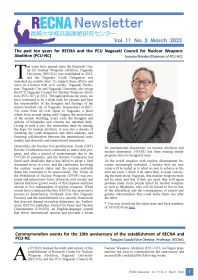
|
_ |
The past ten years for RECNA and the PCU Nagasaki Council for Nuclear Weapons Abolition — Susumu Shirabe Commemoration events for the 10th anniversary of the establishment of RECNA and PCU-NC The Project on “Reducing the risk of Nuclear Weapons Use in Northeast Asia (NU-NEA)” The Eleventh Nagasaki Youth Delegation begin their activities [Full text] * Citation URI: http://hdl.handle.net/10069/00042200 |
Research Center for Nuclear Weapons Abolition, Nagasaki University (RECNA) issued Statement on February 24, 2023.
Statement on the One-Year Anniversary of Russian Invasion of Ukraine
Research Center for Nuclear Weapons Abolition, Nagasaki University (RECNA)
February 24, 2023
One year has passed since the Russian invasion of Ukraine that began on February 24, 2022. There is still no clear path to a ceasefire agreement, and the number of casualties is continuously increasing. On the 21st of this month, Russian President Vladimir Putin announced the suspension of implementation of the New Strategic Arms Reduction Treaty (New START), the only remaining arms control and disarmament treaty between the United States and Russia. On the 23rd he declared that Russia would increase the nuclear capabilities of its land, sea, and air forces. Tensions between the United States and Russia are rising. If the treaty, which has contributed to confidence-building through mutual on-site inspections and periodic consultations, becomes void and Russia returns to the path of nuclear arms expansion, the risk of the use of nuclear weapons will increase and the path to nuclear disarmament may be closed.
RECNA strongly condemns Russia’s stance and urges it to immediately cease its acts of aggression, accompanied by nuclear blackmail, and to work to restore international order based on law. Suspending the implementation of New START and announcing an increase in nuclear capability is also an act in violation of the Nuclear Non-Proliferation Treaty (NPT), which mandates negotiations to achieve nuclear disarmament. Russia should immediately withdraw its suspension of implementation and nuclear force buildup and establish a new framework for arms control and disarmament.
In the context of increased dependence on nuclear deterrence, the responsibility of the other nuclear weapon states, including the United States, as well as the nuclear umbrella states, should also be called into question. In the wake of the invasion of Ukraine and the increased nuclear risk, Europe, Northeast Asia, and other regions are becoming more dependent on nuclear deterrence and are accelerating their arms expansions. Division and confrontation between countries with different interests has deepened, and a situation that should be called a “security dilemma” is now underway.
All nuclear armed states and “nuclear umbrella” states must thoroughly adhere to the “non-use of nuclear weapons” norm that has been in place for more than 77 years, and make the utmost effort to reduce the risk of nuclear weapons use. To this end, they should return to the principle of “a nuclear war cannot be won and must never be fought,” which was reaffirmed in the statement of the five nuclear weapon states on January 3, 2022. It is also significant that the G20 Summit Declaration (November 15, 2022), which includes Russia, clearly states that “the use or threat of use of nuclear weapons is inadmissible.” Nuclear weapon states and nuclear umbrella states have the responsibility to prioritize nuclear risk reduction measures, including confidence building and thorough implementation of crisis management measures, as well as to take steps toward more drastic reduction of the role of nuclear weapons.
Finally, every nation is expected to make efforts to overcome the “security dilemma” and explore ways to achieve common security. The recommendations issued by Group of Eminent Persons for Substantive Advancement of Nuclear Disarmament (March 29, 2018) noted that nuclear deterrence is “a dangerous long-term basis for global security” and that “all states should seek a better long-term solution.” The upcoming Hiroshima G7 Summit must be the starting point for creative discussions on overcoming nuclear deterrence.
Vol.5, Issue 2 of Journal for Peace and Nuclear Disarmament (J-PAND) is now available online. There are 18 open access articles.
For the issue, see here. We have collaborated with the Asia-Pacific Leadership Network for Nuclear Non-Proliferation and Disarmament and the Toda Peace Institute in editing this special issue on “A Nuclear Trilemma in Southern Asia: China, India, and Pakistan.”
IMPLICATIONS OF THE UKRAINE WAR FOR ROK SECURITY
CHEON Myeongguk
December 5, 2022
This report is published under a 4.0 International Creative Commons License the terms of which are found here.
This report is simultaneously published by the Asia-Pacific Leadership Network, Nautilus Institute, and the Research Center for Nuclear Weapons Abolition, Nagasaki University (RECNA).
The views expressed in this report do not necessarily reflect the official policy or position of the Nautilus Institute. Readers should note that Nautilus seeks a diversity of views and opinions on significant topics in order to identify common ground.
In this essay, CHEON Myeongguk explores the possible implications of the Ukraine conflict on the ROK attitudes regarding nuclear weapons. He concludes that the “ROK’s indigenous nuclear option would be a last resort as a deterrence measure against DPRK’s nuclear threat. This option would only be considered by the ROK if Donald Trump were reelected as President of the United States and decided to withdraw US forces from the Korean Peninsula and eventually withdraw the US nuclear umbrella protecting the ROK from DPRK aggression.”
CHEON Myeongguk is a visiting researcher at the Korea Institute for Defense Analyses (KIDA) working on DPRK weapons of mass destruction threats such as nuclear, chemical, and biological weapons and ballistic missiles. Deterrence, protection, counter measures, consequence management, and arms control are also included in his research scopes.
This essay is a contribution to the “Reducing the Risk of Nuclear Weapons Use in Northeast Asia” (NU-NEA) project, a collaboration between the Research Center for Nuclear Weapons Abolition, Nagasaki University, Nautilus Institute, and the Asia Pacific Leadership Network for Nuclear non-proliferation and Disarmament, is to reduce and minimize the risk that nuclear weapons will be used in the region by developing better understandings of the processes that could lead to the first use of nuclear weapons and the potential outcomes of such nuclear weapons use. In the first year of this three-year project, the NU-NEA project team identified over 25 plausible nuclear weapons “use cases” that could start in Northeast Asia, sometimes leading to broader conflict beyond the region. These nuclear use cases are described in the report Possible Nuclear Use Cases in Northeast Asia: Implications for Reducing Nuclear Risk. The project has commissioned five contributions to update the cases in light of the Ukraine conflict, of which this essay is the fifth.
Keywords: Republic of Korea, Russia, Ukraine, North Korea, Nuclear Weapons, Northeast Asia, Deterrence
Authors’ Profile:
CHEON Myeongguk is a visiting researcher at the Korea Institute for Defense Analyses (KIDA) working on DPRK weapons of mass destruction threats such as nuclear, chemical, and biological weapons and ballistic missiles. Deterrence, protection, counter measures, consequence management, and arms control are also included in his research scopes.
RECNA Newsletter Vol.11 No.1 (September 30, 2022)
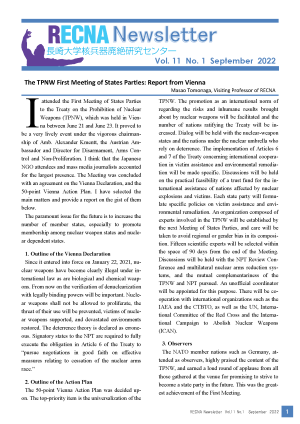
|
_ |
The TPNW First Meeting of States Parties: Report from Vienna — Masao Tomonaga The TPNW First Meeting of States Parties: Working Paper on Victim Assistance “Nagasaki Before the A-Bomb” Slide Materials and “Aerial Photo Archive” Launch of Panel on Peace and Security of Northeast Asia (PSNA) 2 2022 Nagasaki Peace Declaration – Time to Regain an Awareness of Civil Society’s Role Nagasaki Youth Delegation Visits New York [Full text] * Citation URI: http://hdl.handle.net/10069/00041906 |

POTENTIAL IMPLICATIONS OF THE WAR IN UKRAINE FOR NORTHEAST ASIA
Anastasia Barannikova
November 7, 2022
This report is published under a 4.0 International Creative Commons License the terms of which are found here.
This report is simultaneously published by the Asia-Pacific Leadership Network, Nautilus Institute, and the Research Center for Nuclear Weapons Abolition, Nagasaki University (RECNA).
The views expressed in this report do not necessarily reflect the official policy or position of the Nautilus Institute. Readers should note that Nautilus seeks a diversity of views and opinions on significant topics in order to identify common ground.
In this essay, Anastasia Barannikova argues that although the situation in Ukraine does not affect Russia’s nuclear posture/strategy in Northeast Asia directly, indirect impacts of the situation in Ukraine on Russia’s nuclear policies in this region cannot be ruled out. Examples of such indirect impacts include changes in nuclear weapons planning and deployment by the United States and China under the pretext or because of the Ukraine situation, a change in the nuclear weapons status of one or more of the non-nuclear states in the region, or the breaking out of a military conflict over Taiwan or on the Korean peninsula.
Anastasia Barannikova is a research fellow at ADM Nevelskoy Maritime State University (Vladivostok, Russia) and non-resident senior fellow of Mongolian Institute of Northeast Asian Security and Strategy (Mongolia).
This essay is a contribution to the “Reducing the Risk of Nuclear Weapons Use in Northeast Asia” (NU-NEA) project, a collaboration between the Research Center for Nuclear Weapons Abolition, Nagasaki University, Nautilus Institute, and the Asia Pacific Leadership Network for Nuclear non-proliferation and Disarmament, is to reduce and minimize the risk that nuclear weapons will be used in the region by developing better understandings of the processes that could lead to the first use of nuclear weapons and the potential outcomes of such nuclear weapons use. In the first year of this three-year project, the NU-NEA project team identified over 25 plausible nuclear weapons “use cases” that could start in Northeast Asia, sometimes leading to broader conflict beyond the region. These nuclear use cases are described in the report Possible Nuclear Use Cases in Northeast Asia: Implications for Reducing Nuclear Risk. The project has commissioned five contributions to update the cases in light of the Ukraine conflict, of which this essay is the fourth.
Keywords: Russia, Ukraine, Nuclear Weapons, Northeast Asia
Authors’ Profile:
Anastasia Barannikova is a research fellow at ADM Nevelskoy Maritime State University (Vladivostok, Russia) and non-resident senior fellow of Mongolian Institute of Northeast Asian Security and Strategy (Mongolia).

POTENTIAL IMPLICATIONS OF THE WAR IN UKRAINE FOR NORTHEAST ASIA
Paul K. Davis
October 27, 2022
This report is published under a 4.0 International Creative Commons License the terms of which are found here.
This report is simultaneously published by the Asia-Pacific Leadership Network, Nautilus Institute, and the Research Center for Nuclear Weapons Abolition, Nagasaki University (RECNA).
The views expressed in this report do not necessarily reflect the official policy or position of the Nautilus Institute. Readers should note that Nautilus seeks a diversity of views and opinions on significant topics in order to identify common ground.
In this Policy Forum essay, Paul Davis argues: “Anyone sensible worries that a first nuclear use might well lead to escalation and general nuclear war, but the adjective “inexorably” should no longer be included.” He concludes that the Ukraine war has made the range of nuclear-use cases in Northeast Asia that he identified in 2020 even more plausible.
Paul K. Davis is a professor of policy analysis at the Pardee RAND Graduate School and a retired adjunct Senior Principal Researcher at RAND. He received a B.S. in chemistry from the University of Michigan and a Ph.D. in chemical physics from the Massachusetts Institute of Technology. He worked in strategic warning technology and systems analysis before joining the U.S. government to work on strategic force planning and arms control. As a Senior Executive, he then headed analysis of global military strategy and related defense programs in the Office of Program Analysis and Evaluation. He then joined the RAND Corporation, where his research has dealt with strategic planning under deep uncertainty; deterrence theory; modeling; information fusion; and causal social science for policy applications. He has served on numerous national panels and journal editorial boards. He developed and conducted a prescient nuclear-crisis war game in Seoul in 2016. His most recent major work (co-edited) is Social Behavioral Modeling for Complex Systems (2019), Wiley & Sons. This essay represents his own analysis and is unrelated to RAND research.
This essay is a contribution to the “Reducing the Risk of Nuclear Weapons Use in Northeast Asia” (NU-NEA) project, a collaboration between the Research Center for Nuclear Weapons Abolition, Nagasaki University, Nautilus Institute, and the Asia Pacific Leadership Network for Nuclear nonproliferation and Disarmament. The project’s goal is to reduce and minimize the risk that nuclear weapons will be used in the region by developing better understandings of the processes that could lead to the first use of nuclear weapons and the potential outcomes of such nuclear weapons use. In the first year of this three-year project, the NU-NEA project team identified over 25 plausible nuclear weapons “use cases” that could start in Northeast Asia, sometimes leading to broader conflict beyond the region. These nuclear use cases are described in the report Possible Nuclear Use Cases in Northeast Asia: Implications for Reducing Nuclear Risk. The project has commissioned five contributions to update the cases in light of the Ukraine conflict, of which this essay is the second.
Keywords: United States, East Asia, Russia, Ukraine, Nuclear Use, Ukraine, NATO, Biden, Putin
Authors’ Profile:
Paul K. Davis is a professor of policy analysis at the Pardee RAND Graduate School and a retired adjunct Senior Principal Researcher at RAND. He received a B.S. in chemistry from the University of Michigan and a Ph.D. in chemical physics from the Massachusetts Institute of Technology. He worked in strategic warning technology and systems analysis before joining the U.S. government to work on strategic force planning and arms control. As a Senior Executive, he then headed analysis of global military strategy and related defense programs in the Office of Program Analysis and Evaluation. He then joined the RAND Corporation, where his research has dealt with strategic planning under deep uncertainty; deterrence theory; modeling; information fusion; and causal social science for policy applications. He has served on numerous national panels and journal editorial boards. He developed and conducted a prescient nuclear-crisis war game in Seoul in 2016. His most recent major work (co-edited) is Social Behavioral Modeling for Complex Systems (2019), Wiley & Sons. This essay represents his own analysis and is unrelated to RAND research.
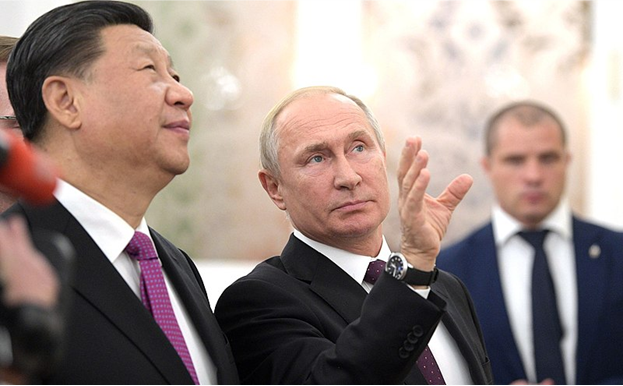
IMPLICATIONS OF RUSSIA’S NUCLEAR SIGNALING DURING THE UKRAINE WAR FOR CHINA’S NUCLEAR POLICY
TONG ZHAO
October 13, 2022
This report is published under a 4.0 International Creative Commons License the terms of which are found here.
This report is simultaneously published by the Asia-Pacific Leadership Network, Nautilus Institute, and the Research Center for Nuclear Weapons Abolition, Nagasaki University (RECNA).
The views expressed in this report do not necessarily reflect the official policy or position of the Nautilus Institute. Readers should note that Nautilus seeks a diversity of views and opinions on significant topics in order to identify common ground.
In this Policy Forum essay, Tong Zhao argues that China fundamentally sees the Ukraine conflict as being caused by hegemonic behavior by the US-led West forcing Russia’s hand. China has been watching and learning from Russia’s implicit use of nuclear threat, and the lessons learned may add further ambiguity and uncertainty to the interpretation and application of China’s No First Nuclear Use policy in potential conflict situations, including those involving Taiwan.
Tong Zhao is a visiting research scholar at Princeton University’s Science and Global Security Program, as well as a senior fellow in the Nuclear Policy Program at the Carnegie Endowment for International Peace. His research focuses on strategic security issues, such as nuclear weapons policy, deterrence, arms control, nonproliferation, missile defense, hypersonic weapons, and China’s security and foreign policy.
This essay is a contribution to the “Reducing the Risk of Nuclear Weapons Use in Northeast Asia” (NU-NEA) project, a collaboration between the Research Center for Nuclear Weapons Abolition, Nagasaki University, Nautilus Institute, and the Asia Pacific Leadership Network for Nuclear non-proliferation and Disarmament, is to reduce and minimize the risk that nuclear weapons will be used in the region by developing better understandings of the processes that could lead to the first use of nuclear weapons and the potential outcomes of such nuclear weapons use. In the first year of this three-year project, the NU-NEA project team identified over 25 plausible nuclear weapons “use cases” that could start in Northeast Asia, sometimes leading to broader conflict beyond the region. These nuclear use cases are described in the report Possible Nuclear Use Cases in Northeast Asia: Implications for Reducing Nuclear Risk. The project has commissioned five contributions to update the cases in light of the Ukraine conflict, of which this essay is the second.
Keywords: United States, Nuclear Strategy, Nuclear Use, Northeast Asia, China, Russia, Ukraine
Authors’ Profile:
Tong Zhao is a Senior Fellow at the Nuclear Policy Program of the Carnegie Endowment for International Peace, based in Beijing at the Carnegie–Tsinghua Center for Global Policy. His research focuses on strategic security issues, including nuclear arms control, nonproliferation, missile defense, space security, strategic stability, and China’s security and foreign policy. Zhao was previously a Stanton Nuclear Security Fellow at the Belfer Center for Science and International Affairs at Harvard University. He also has experience as a nonresident WSD-Handa Fellow at the Pacific Forum CSIS, and working for the Office of Foreign Affairs of the
People’s Government of Beijing Municipality. He holds a PhD in science, technology, and international affairs from the Georgia Institute of Technology, and received a B.S. in physics and an M.A. in international relations from Tsinghua University.
“New Challenges for a World Free of Nuclear Weapons — Message from Nagasaki —” [JPN]
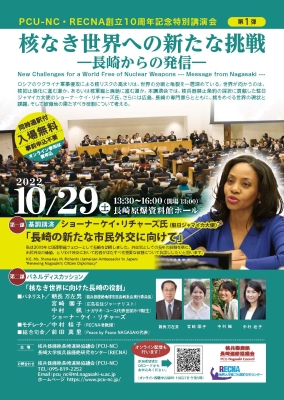 The heightened nuclear risk from Russia’s military invasion of Ukraine is further deepening the world’s divisions and fissures. Is the world headed down the path of strengthening nuclear deterrence or nuclear disarmament and abolition?
The heightened nuclear risk from Russia’s military invasion of Ukraine is further deepening the world’s divisions and fissures. Is the world headed down the path of strengthening nuclear deterrence or nuclear disarmament and abolition?
In this lecture, together with the Jamaican Ambassador to Japan, H.E. Ms. Shorna-Kay M. Richards, who contributed to the adoption of the Treaty on the Prohibition of Nuclear Weapons (TPNW), as well as experts from Hiroshima and Nagasaki, we will consider the current world situation and challenges concerning nuclear weapons and the role that the A-bombed cities should play in the world.
“Renewing Nagasaki’s Citizen Diplomacy”
“Nagasaki’s Role for a Nuclear Free World”
Sonoko MIYAZAKI (Journalist, Lives in Hiroshima)
Kaede NAKAMURA (8th and 9th Nagasaki Youth Delegation)
Shorna-Kay M. RICHARDS
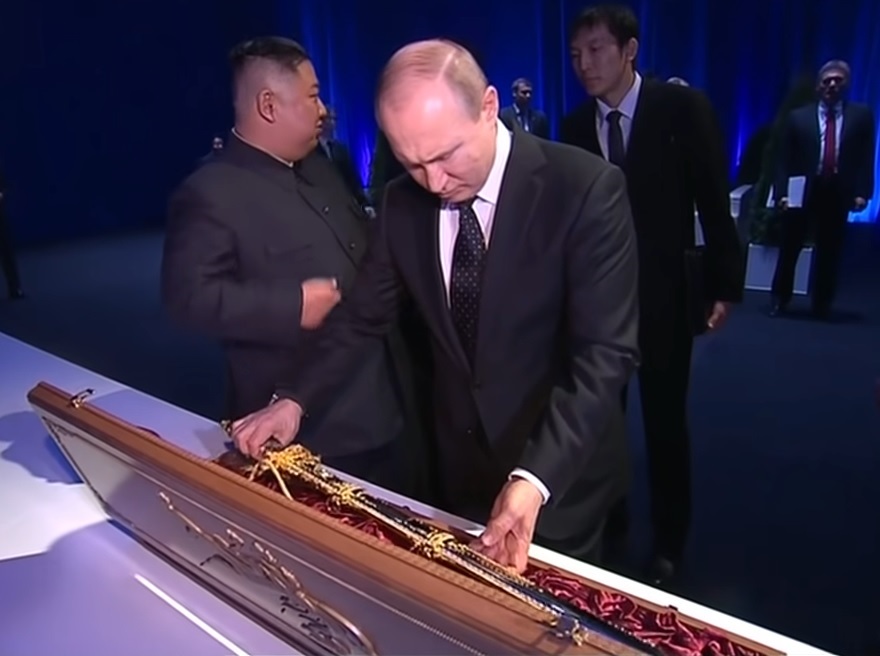
BIRDS OF A FEATHER: THOUGHTS ON PYONGYANG’S LESSONS
FROM THE WAR IN UKRAINE
ALEXANDRE Y. MANSOUROV
October 7, 2022
This report is published under a 4.0 International Creative Commons License the terms of which are found here.
This report is simultaneously published by the Asia-Pacific Leadership Network, Nautilus Institute, and the Research Center for Nuclear Weapons Abolition, Nagasaki University (RECNA).
The views expressed in this report do not necessarily reflect the official policy or position of the Nautilus Institute. Readers should note that Nautilus seeks a diversity of views and opinions on significant topics in order to identify common ground.
The overall objective of the “Reducing the Risk of Nuclear Weapons Use in Northeast Asia” (NU-NEA) project, a collaboration between the Research Center for Nuclear Weapons Abolition, Nagasaki University, Nautilus Institute, and the Asia Pacific Leadership Network for Nuclear non-proliferation and Disarmament, is to reduce and minimize the risk that nuclear weapons will be used in the region by developing better understandings of the processes that could lead to the first use of nuclear weapons and the potential outcomes of such nuclear weapons use. In the first year of this three-year project, the NU-NEA project team identified over 25 plausible nuclear weapons “use cases” that could start in Northeast Asia, sometimes leading to broader conflict beyond the region. These nuclear use cases are described in the report Possible Nuclear Use Cases in Northeast Asia: Implications for Reducing Nuclear Risk1.
On February 24, 2022, not long after the year 1 report was published, the Russian Federation launched what it described as a “Special Military Operation” in Ukraine. The Ukraine conflict, as it has unfolded in the intervening months, has riveted the attention of the world, changed many relationships between countries, and also changed perceptions of warfare. The NU-NEA project team realized that the changes catalyzed by the Ukraine conflict could change the way that nuclear-armed nations, and those nations that might choose to obtain such weapons in the future, think about deploying or using nuclear weapons in Northeast Asia. To address these possible changes in approach, the project team asked experts to provide input on how the Ukraine conflict might have changed the way that policymakers and military planners in each nation in Northeast Asia, plus the United States, think about their nation’s deployment or use of nuclear weapons in the event of escalation of a conflict in Northeast Asia.
In the Policy Forum essay that follows, Professor Alexandre Y. Mansourov provides his analysis of what lessons the Democratic Peoples’ Republic of Korea (DPRK) might have taken, to date, from how the Ukraine conflict has unfolded, and how those lessons may change how and under what conditions the DPRK might choose to deploy or use nuclear weapons if a conflict in Northeast Asia escalates sufficiently. Professor Mansourov argues that the lessons learned from the Ukraine conflict by DPRK leadership may make the DPRK more likely to conclude that having nuclear weapons capability will not necessarily translate to victory in a war on the Korean peninsula, that the results of Russia’s nuclear posturing during the war conflict will make the DPRK less likely to resort to nuclear weapons use, that the DPRK will be more likely to consider and perhaps pursue “nuclear sharing” arrangements with Russia and China, that the DPRK would be more likely to insist on the exclusion of tactical nuclear weapons from any eventual nuclear arms control deal with the United States and the international community, and that the Ukraine conflict may affect how the DPRK thinks about nuclear facilities in both the DPRK and the Republic of Korea as potential targets during conflicts.
1 Available as https://nautilus.org/napsnet/napsnet-special-reports/possible-nuclear-use-cases-in-northeast-asia-implications-for-reducing-nuclear-risk/.
Keywords: Nuclear weapons, deterrence, perceptions, Ukraine, United States, North Korea
Authors’ Profile:
Alexandre Y. Mansourov is Adjunct Associate Professor at the Center for Security Studies at Georgetown University, Adjunct Professor of Korean Studies at SAIS Johns Hopkins
University, Adjunct Professor of Political Science and International Affairs at the Elliott School of International Affairs, George Washington University, and Chairman of Great Falls
Solutions International, LLC.


















